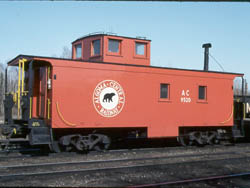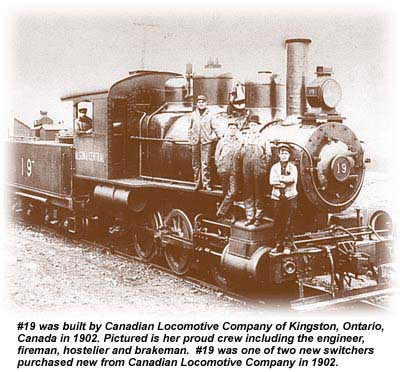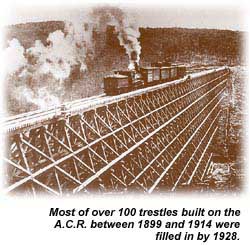

|
This is what my caboose looked like about 28 years ago!
|

100 Years of
Rail History
The Algoma Central Railway Company was incorporated August 11, 1899 and
was known as such until May 23, 1901 when, with plans to push the line
to Hudson Bay, the name was changed to the Algoma Central and Hudson Bay
Railway Company. By 1914 track was laid as far north as Hearst, Ontario
and shortly after plans to reach Hudson Bay were abandoned. The name was
changed on June 30, 1965 to the Algoma Central Railway and then, with
the purchase of the Railway by Wisconsin Central Transportation Corporation
on February 1st, 1995, its name was changed to Algoma Central Railway
Inc.
 STARTED IN
1899
STARTED IN
1899
Francis H. Clergue was a U.S. industrialist
who first visited our region in 1892 and foresaw the opportunities for
growth as an industrial centre and it was his vision that laid the foundation
for the present day city of Sault Ste. Marie. Clergue's persuasive style
and boundless optimism attracted investment dollars which enabled him
to develop twelve major enterprises including a steel mill, a pulp mill,
two railways, two power and light utilities, a street car system and a
fleet of steamships.
The discovery of the iron
ore deposit at Wawa by a prospector named Boyer, was the catalyst for
the steel industry in Sault Ste. Marie and a driving force of the Railway's
construction.
Construction of the railway
commenced in 1899 and by the time of the Clergue empire's industrial crash
in 1903, rail had been laid to Mile 56 on the main line north from Sault
Ste. Marie and from the Michipicoten Harbour to Josephine, six miles from
the intended main line connection at Hawk Junction.
 Construction of the line did not resume until 1909 and the main line north
of Sault Ste. Marie connected with the Michipicoten branch line at Hawk
Junction in 1911. The main line crossed the Canadian Pacific rail line
at Franz (Mile 194.9) by mid-1912 and then crossed the Canadian Nationals
line at Oba (Mile 244.7) six months later. The line reached its northern
terminus in Hearst, Ontario in 1914. The Railway has 322 miles of main
line track - 296 miles from Sault Ste. Marie to Hearst and 26 miles from
Hawk Junction to Michipicoten Harbour on Lake Superior.
Construction of the line did not resume until 1909 and the main line north
of Sault Ste. Marie connected with the Michipicoten branch line at Hawk
Junction in 1911. The main line crossed the Canadian Pacific rail line
at Franz (Mile 194.9) by mid-1912 and then crossed the Canadian Nationals
line at Oba (Mile 244.7) six months later. The line reached its northern
terminus in Hearst, Ontario in 1914. The Railway has 322 miles of main
line track - 296 miles from Sault Ste. Marie to Hearst and 26 miles from
Hawk Junction to Michipicoten Harbour on Lake Superior.
TOUGH GOING
The location and construction of the railway through dense forests, rugged
hills, across rivers and deep ravines was a vastly different job at the
turn of the century compared with present day construction and would even
challenge today's railway builders. The 10 mile stretch between Mile 68 and
Mile 78 was one of the most difficult sections to construct. Records
indicate that it took over 2000 men, working an entire summer to complete
this 10 mile stretch. After the dealing with the rock, the brush fires,
blackflies and booze were the other obstacles the railway had to overcome.
The stories say that the labourer's enthusiasm for work was often dampened
by an abundance of whiskey.
 To build the section of track from Michipicoten Harbour, all construction
material, including locomotives, freight cars etc. had to be transported
north from Sault Ste. Marie on the steamships, Manitou and Caribou. The
Canadian Pacific Railway, whose line crosses the Algoma Central line at
Franz, also made use of this transportation route.
To build the section of track from Michipicoten Harbour, all construction
material, including locomotives, freight cars etc. had to be transported
north from Sault Ste. Marie on the steamships, Manitou and Caribou. The
Canadian Pacific Railway, whose line crosses the Algoma Central line at
Franz, also made use of this transportation route.
The section from Frater to Agawa Canyon was an engineering feat in itself
with the track dropping 500ft/152.3m over 12 miles to the bottom of the
canyon floor. As the track exits the canyon at mile 116 the track hugs the
Agawa River and the canyon walls are only 50ft/15.2m apart.
DIESELIZED IN 1952
Algoma Central Railway was the first Canadian steam railway to completely
switch over to diesel operations. Dieselization had an impact on operating
efficiencies and the companies bottom line and in 1959, 60 years after
start-up, shareholders received their first dividend cheque.
 END OF AN ERA
END OF AN ERA
In late 1997, Algoma Steel Inc. announced that it would be shutting down
its low grade ore mining operations in Wawa, the same ore body discovered
by Boyer, in favour of higher grade ore from the Tilden Mine outside of
Marquette, Michigan. With the closing of the Algoma Ore Division, a final
ore train consisting of 18 cars, rumbled along the branch line to Hawk
Junction and then down to the Sault on June 25, 1998 and with it an
important chapter in the Railway's 100 year history came to a close.
Historical Information Courtesy of Algoma Central Railway, Incorporated
|



 STARTED IN
1899
STARTED IN
1899  Construction of the line did not resume until 1909 and the main line north
of Sault Ste. Marie connected with the Michipicoten branch line at Hawk
Junction in 1911. The main line crossed the Canadian Pacific rail line
at Franz (Mile 194.9) by mid-1912 and then crossed the Canadian Nationals
line at Oba (Mile 244.7) six months later. The line reached its northern
terminus in Hearst, Ontario in 1914. The Railway has 322 miles of main
line track - 296 miles from Sault Ste. Marie to Hearst and 26 miles from
Hawk Junction to Michipicoten Harbour on Lake Superior.
Construction of the line did not resume until 1909 and the main line north
of Sault Ste. Marie connected with the Michipicoten branch line at Hawk
Junction in 1911. The main line crossed the Canadian Pacific rail line
at Franz (Mile 194.9) by mid-1912 and then crossed the Canadian Nationals
line at Oba (Mile 244.7) six months later. The line reached its northern
terminus in Hearst, Ontario in 1914. The Railway has 322 miles of main
line track - 296 miles from Sault Ste. Marie to Hearst and 26 miles from
Hawk Junction to Michipicoten Harbour on Lake Superior.
 To build the section of track from Michipicoten Harbour, all construction
material, including locomotives, freight cars etc. had to be transported
north from Sault Ste. Marie on the steamships, Manitou and Caribou. The
Canadian Pacific Railway, whose line crosses the Algoma Central line at
Franz, also made use of this transportation route.
To build the section of track from Michipicoten Harbour, all construction
material, including locomotives, freight cars etc. had to be transported
north from Sault Ste. Marie on the steamships, Manitou and Caribou. The
Canadian Pacific Railway, whose line crosses the Algoma Central line at
Franz, also made use of this transportation route.  END OF AN ERA
END OF AN ERA
